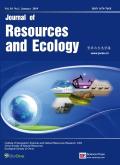Optimization of the Ecological Security Pattern in Xi'an City Based on a Minimum Cumulative Resistance Model
Q3 Environmental Science
引用次数: 0
Abstract
The ecological security pattern is conducive to promoting the harmonious integration of regional development and ecological protection. Taking Xi'an, a core city in the west of China, as an example, the ecological source area was identified based on an assessment of the importance of ecological services and the sensitivity of the ecological environment. Then the minimum cumulative resistance model and gravity model were used to construct the regional ecological security pattern and optimize the ecological spatial structure layout. The results show four key aspects of this system. (1) The source area of ecological protection identified in this study was 3352.5 km2, accounting for 33.2% of the city, and it is mainly distributed in the Qinling Mountains, Lishan Hills, Weihe River, Heihe River, and Jinghe River. (2) Excluding the ecological source area, the low, medium and high-level security pattern areas accounted for 27.21%, 15.95% and 14.31% of the whole area, respectively. (3) The models generated 21 potential corridors with a total length of about 105.24 km, including 9 key corridors. (4) In order to optimize the ecological spatial structure of Xi'an, one proposal is to build an ecological security network layout system with “one barrier, one belt, several corridors, multiple areas and multiple points” as the core.基于最小累积阻力模型的西安市生态安全格局优化
生态安全格局有利于促进区域发展与生态保护的和谐结合。以西部核心城市西安市为例,通过对西安市生态服务功能重要性和生态环境敏感性的评价,确定了西安市的生态源区。利用最小累积阻力模型和重力模型构建区域生态安全格局,优化生态空间结构布局。结果显示了该系统的四个关键方面。(1)研究确定的生态保护源面积为3352.5 km2,占全市面积的33.2%,主要分布在秦岭、骊山、渭河、黑河、精河等地区。(2)除去生态源区,低、中、高安全格局区分别占总面积的27.21%、15.95%和14.31%。(3)模型共生成21个潜在廊道,总长度约105.24 km,其中重点廊道9个。(4)为优化西安市生态空间结构,建议构建以“一障、一带、多廊、多区、多点”为核心的生态安全网络布局体系。
本文章由计算机程序翻译,如有差异,请以英文原文为准。
求助全文
约1分钟内获得全文
求助全文
来源期刊

Journal of Resources and Ecology
Environmental Science-Ecology
CiteScore
2.40
自引率
0.00%
发文量
107
 求助内容:
求助内容: 应助结果提醒方式:
应助结果提醒方式:


